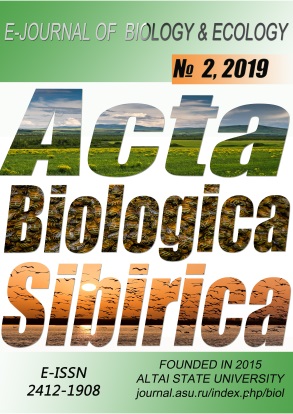Abstract
The agrolandscape in Northwestern Russia (fields and field borders, forest edges and separate forest plots) include 12 species of ants (Hymenoptera, Formicidae), which belong to four genera. On the fields of different farm crops, we have collected 8 different ant species. Myrmica rubra and Lasius niger are the basic species on the fields. These are eurytopic species, capable of building nests in the ground. M. rubra and L. niger are much rarer on the cultivated lands than on the surrounding biotopes – field borders and forest edges.
References
Fabrisheva, O.A. & Belova, Yu.N. (2009). Materials on the ant fauna of the Vologda Region. Ants and forest protection. Materials of the 13th All-Russian
Myrmecological Symposium, Nizhny Novgorod, 26˗30 August 2009. Nizhny Novgorod, 121–123 (In Russian).
Guseva, O.G. (2018). Distribution of ground beetles of the genus Poecilus Bonelli, 1810 (Coleoptera, Carabidae) in the agrolandscape in Northwestern Russia. Acta Biologica Sibirica, 4(3), 85–90 (In Russian). DOI: https://doi.org/10.14258/abs.v4i3.4414
Guseva, O.G. (2019). Investigation of biodiversity and distribution of rove beetles (Coleoptera, Staphylinidae) in the agrolandscape in Northwestern Russia. Acta Biologica Sibirica, 5(1), 12–18. (In Russian). DOI: http://dx.doi.org/10.14258/abs.v5.i1.5185
Guseva, O.G. & Koval, A.G. (2019). Distribution of ground beetles of the genus Amara Bonelli, 1810 (Coleoptera, Carabidae) in the agrolandscape in Northwestern Russia. Acta Biologica Sibirica, 5(1), 85–90. DOI: https://doi.org/10.14258/abs.v5.i1.5192
Koval, A.G. & Guseva, O.G. (2018). Rare and threatened arthropod species in agrolandscapes of the Leningrad Region of Russia. Plant Protection News, 2, 61–63 (In Russian).
Koval, A.G., Guseva, O.G., & Shpanev, A.M. (2018). Hoverflies (Diptera, Syrphidae) in agrolandscapes of St. Petersburg and Leningrad Province. Entomological Review, 98 (6), 415–422. DOI: https://doi.10.1134/S0013873818060064
Mabelis, A.A. & Korczyńska, J. (2016). Long-term impact of agriculture on the survival of wood ants of the Formica rufa group (Formicidae). J. Insect Conserv., 20, 621–628. DOI: https://doi.10.1007/s10841-016-9803-7
Malyshev, D.S. (2009). Settlements of ants of genus Formica as annals of forest communities. Ants and forest protection. Materials of the 13th All-Russian Myrmecological Symposium, Nizhny Novgorod, 26˗30 August 2009. Nizhny Novgorod, 226–228 (In Russian).
Malysheva, M.S. (1979). Predation of ants of genus Formica on fields of grain and row crops. Ants and forest protection. VI. Tartu, 39–42 (In Russian).
Novgorodova, T.A. (2015) Ecological and ethological aspects of the interaction of ants with aphids and aphidophages at different levels of social organization. Abstract of the dissertation of the DSc in Biology. Novosibirsk, 1˗37 (In Russian).
Prisyazhnyuk, V.E., Sviridov, A.V., Akhundov, A.G., Nikitsky, N.B., & Antropov, A.V. (2008). Red List of rare and endangered species of animals and plants, which particularly protected in Russia. Part 2 (Invertebrates). Moscow: Research Institute of Nature Protection (In Russian).
Rybalov, L.B. (2005). The influence of red wood ants on composition of soil invertebrates in «Friendship Park» (Karelia-Finland). Ants and forest protection. Materials of the 12th All-Russian Myrmecological Symposium, Novosibirsk, 7˗14 August 2005. Novosibirsk, 259–263 (In Russian).
Shtuchny, N.A. (2005). Condition diagnostics of F. aquilonia complexes in the north part of Moscow Area. Ants and forest protection. Materials of the 12th All-Russian Myrmecological Symposium, Novosibirsk, 7˗14 August 2005. Novosibirsk, 311–315 (In Russian).
Sorokina, S.V. (1998). Anthropogenic effect on the ant faunas of urban ecosystems. Ants and forest protection. Materials of the 10th All-Russian Myrmecological Symposium, Moscow, 24–28 August 1998. Moscow, 157–158 (In Russian).
Stukalyuk, S.V. (2017). Stratification of the ant species (Hymenoptera, Formicidae) in the urban broadleaf woodlands of the city of Kiev. Entomological Review, 97 (3), 320–343. DOI: https://doi.10.1134/S001387381703006X
Vepsäläinen, K., Ikonen, H., & Koivula, M.J. (2008). The structure of ant assemblages in urban area of Helsinki, southern Finland. Ann. Zool. Fennici, 45, 109–127.
Zakharov A.A. (2015). Ants of forest communities, its life and role in the forest. Moscow: KMK Scientific Press (In Russian).
Acta Biologica Sibirica is a golden publisher, as we allow self-archiving, but most importantly we are fully transparent about your rights.
Authors may present and discuss their findings ahead of publication: at biological or scientific conferences, on preprint servers, in public databases, and in blogs, wikis, tweets, and other informal communication channels.
ABS allows authors to deposit manuscripts (currently under review or those for intended submission to ABS) in non-commercial, pre-print servers such as ArXiv.
Authors who publish with this journal agree to the following terms:
- Authors retain copyright and grant the journal right of first publication with the work simultaneously licensed under a Creative Commons Attribution License (CC BY 4.0) that allows others to share the work with an acknowledgement of the work's authorship and initial publication in this journal.
- Authors are able to enter into separate, additional contractual arrangements for the non-exclusive distribution of the journal's published version of the work (e.g., post it to an institutional repository or publish it in a book), with an acknowledgement of its initial publication in this journal.
- Authors are permitted and encouraged to post their work online (e.g., in institutional repositories or on their website) prior to and during the submission process, as it can lead to productive exchanges, as well as earlier and greater citation of published work (See The Effect of Open Access).

